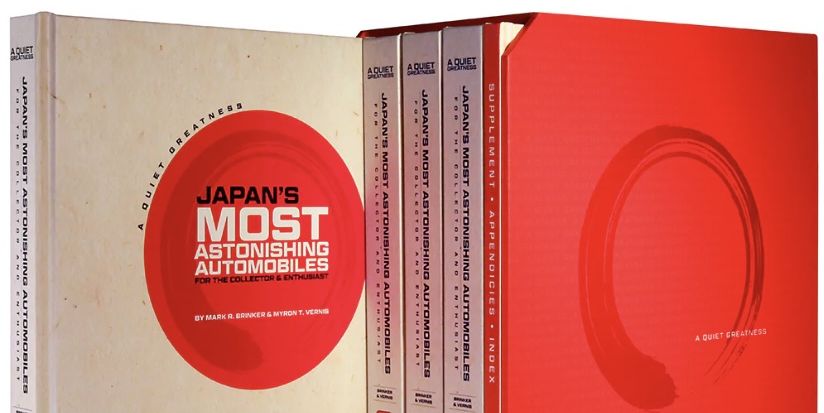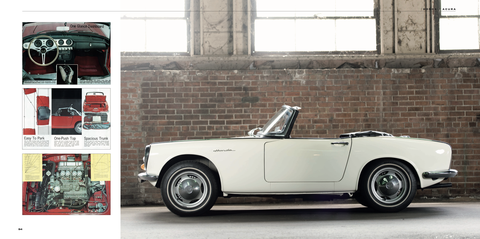'A Quiet Greatness' Is a Multi-Volume Celebration of Japanese Collectible Cars

Myron Vernis is 67 and has been an automotive aficionado for his whole life. But about 10 years ago, he started to sour on the collector-car world. “The old white guys of my generation who were my friends were getting to be bitter old men,” he told Car and Driver. “All they kept talking about was how young people didn’t care about cars anymore. And instead of talking about how we can make our cars more accessible, or better resources for others, all they wanted to talk about was how much their cars were worth.” Boring, Boomer.
For Sale by the Authors
Fortunately, Vernis attended an event that shifted his perspective. “I was in Los Angeles and ended up at a Japanese car show, and I saw this huge enthusiasm for Japanese cars by people half to a third of my age. The same type of enthusiasm and passion for cars I’d had when I was young,” he said. This invigorated him, and he began making friends in this community and collecting rare and oddball Japanese cars.
In pursuing this fresh endeavor, he came to realize that there were many gaps in his knowledge, but he was surprised to find that there wasn’t one cohesive, published resource that could assist him. So he and a longtime friend (and fellow Japanese car fanatic), Mark Brinkman, decided to create one. That’s when things got out of hand. “Our initial plan was to do a nice coffee-table book of about 300 pages,” Vernis said. They started out by listing cars they thought should be included. “Then, as we started doing more research, we started finding more cars that we thought were cool. Eventually, it kind of grew into this 1400-page, four-and-a-half-volume set.”
“The Japanese with their cars were like the French with their wine: They kept the best stuff for themselves.”
The set is called A Quiet Greatness and is a lavishly produced, $350, 35-pound tome that features information, statistics, technical specs, trivia, history, and over 2200 images of the coolest Japanese Domestic Market (JDM) cars you’ve ever, or never, seen. “The Japanese with their cars were like the French with their wine, they kept the best stuff to themselves,” Vernis explained. (Former Road & Track art director Richard Baron assisted with the book’s lovely design.)
A quick thumbing through reveals the astounding breadth of the Japanese car market. The handmade Autech Zagato Stelvio sports car. The creamy V-12–powered Toyota Century luxury sedan. The miniature snake-in-a-backward-baseball-cap Yahama Ami. The gullwinged Suzuki Cara, Mazda AZ-1, and Toyota Sera. The Michelotti-designed, Alfa-esque, rear-engined Hino Contessa. And the list goes on and on. You can barely turn a page in any of the volumes without coming upon some new tidbit, achievement, or vehicle.

Courtesy: Myron Vernis/Mark Brinker
One of the authors’ core goals was to help raise the status of Japanese collectible cars, an admirable mission. But this ran them into a bit of a Catch-22 when seeking a publishing house. “There were a lot of higher-end book publishing houses that, when we sent them the digital files of the book, were totally blown away by it,” Vernis said. “But they said it’s about Japanese cars, and they didn’t think they could sell it to anybody. So, we wanted to do it to elevate the level of this part of the hobby, but the actual people who could help us do that weren’t interested in doing it because it’s not at that level yet.”

Courtesy: Myron Vernis/Mark Brinkman
Vernis and Brinker decided to self-publish the book, a financially daunting decision. But this wasn’t even the priciest aspect of creating A Quiet Greatness. “The most expensive part of the project was discovering cars, then having to go out and buy them,” Vernis said, laughing. As a result of the process, the two of them bought a total of 18 Japanese cars.
Though Vernis has scores of cars in his collection, he does have one unicorn. “For me, it’s a Mitsuoka Orochi. It’s just the craziest thing. People will look at it and either say it’s the coolest car ever made, or the ugliest car ever made,” he said. Orochis are not yet legal in the United States because vehicles that weren’t originally available here need to be over 25 years old in order to be eligible for import. Vernis’s goal is to have the first one legally brought into the United States.
His affection for the Orochi led us to wonder if there was any car in the book that he wouldn’t want to own. “I’m an automotive omnivore,” he said. “I can honestly say there’s nothing in the book that I don’t love.”
This content is imported from OpenWeb. You may be able to find the same content in another format, or you may be able to find more information, at their web site.



